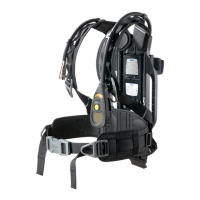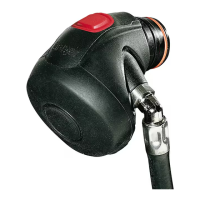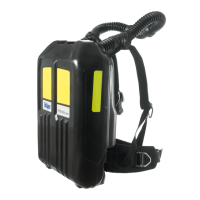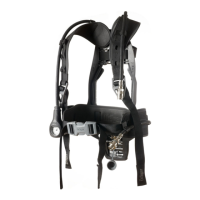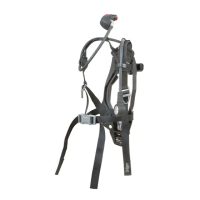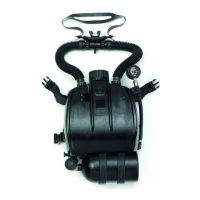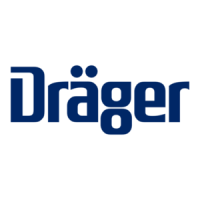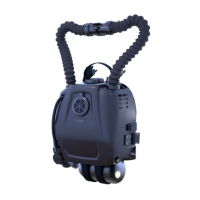3361123 (A3-D-P) Page 1 of 5
3361123
© Dräger Safety UK Limited
Edition 12 – March 2018 (Edition 01 – July 2012)
Subject to alteration
Draeger Safety UK Limited
Ullswater Close Tel +44 1670 352 891
Blyth, NE24 4RG Fax +44 1670 356 266
United Kingdom www.draeger.com
1 For your safety
1.1 General safety statements
● Before using this product, carefully read the instructions for use.
● Strictly follow the instructions for use. The user must fully understand
and strictly observe the instructions. Use the equipment only for the
purposes specified in this document.
● Do not dispose of the instructions for use. Ensure that they are
retained and appropriately used by the product user.
● Only fully trained and competent users are permitted to use this
product.
● Comply with all local and national rules and regulations associated
with this product.
● Only trained and competent personnel are permitted to inspect, repair
and service the product. Dräger recommend a Dräger service contract
for all maintenance activities and that all repairs are carried out by
Dräger.
● Properly trained service personnel must inspect and service this
product as detailed in the Maintenance section of this document.
● Use only genuine Dräger spare parts and accessories, or the proper
functioning of the product may be impaired.
● Do not use a faulty or incomplete product, and do not modify the
product.
● Notify Dräger in the event of any component fault or failure.
● Use of the apparatus should be consistent with NFPA 1500 – Standard
on Fire Department Occupational Safety and Health Program.
● All approved respiratory equipment shall be selected, fitted, used, and
maintained in accordance with MSHA (Mine Safety and Health
Administration), OSHA (Occupational Safety and Health
Administration), and other applicable regulations.
● Do not use any form of chemical marking or paint on the equipment.
● The air supply shall meet the requirements for breathing air according to
CGA G – 7.1, Grade D or higher quality and, where appropriate, be in
accordance with: NFPA 1989 Standard on Breathing Air Quality for
Emergency Services Respiratory Protection.
● Before occupational use of this respirator a written respiratory
protection program must be implemented meeting all the local
government requirements. In the United States employers must
comply with OSHA 29 CFR 1910.134 which includes medical
evaluation, training, and fit testing.
CAUTION
This device has been tested and complies with the FCC (Federal
Communications Commission) rules. Changes or modifications not
expressly approved by the manufacturer will void your authority to operate
this product.
1.2 Definitions of alert icons
Alert icons are used in this document to provide and highlight text that
requires a greater awareness by the user. A definition of the meaning of
each icon is as follows:
WARNING
Indicates a potentially hazardous situation which, if not avoided, could
result in death or serious injury.
CAUTION
Indicates a potentially hazardous situation which, if not avoided, could
result in physical injury. It may also be used to alert against unsafe
practices.
NOTICE
Indicates additional information on how to use the product.
1.3 Trademarks
FPS
®
is a registered trademark of Dräger in the United States and/or other
countries. Contact Dräger for details.
Procell
®
and Duracell
®
are registered trademarks of Duracell U.S.
Operations, Inc. in the United States and/or other countries.
Panasonic
®
is a registered trademark of Panasonic Corporation, Japan in
the United States and/or other countries.
Dow Corning
®
and Molykote
®
are registered trade marks of Dow Corning
Corporation in the United States and/or other countries.
Spur-Tex
®
is a registered trade mark of Spurrier Chemicals Companies,
Inc. in the United States and/or other countries.
2 Description
2.1 Product overview
The Dräger PSS 5000 Series is a compact and lightweight breathing
apparatus that provides the wearer with respiratory protection using an
open-circuit, pressure-demand, compressed-air system. The apparatus
can be used as a self-contained system, or with an independent air supply
for supplied-air resPSSpirator (SAR) operations. The series is compatible
with a wide range of Dräger compressed-air cylinders and face masks (e.g.
FPS
®
7000 face masks, and aluminum or composite cylinders). The
product includes the following electronic monitoring systems:
● A Dräger Sentinel 7000 electronic monitoring system, with integral
PASS (personal alert safety system).
● A Dräger FPS
®
7000 wireless HUD (head-up display) unit.
2.2 Feature description
The carrying system has a carbon-composite backplate, with adjustable
shoulder straps and waist belt connected using quick release connectors.
The waist pad is connected at a flexible joint to compensate for the twisting
and bending of the user.
All variants use the same high-performance first-stage regulator (Fig A,
Item 5) fitted with a whistle that sounds at the end-of-service time (EOST)
(see Section 8 for the EOST activation pressures). The regulator supplies
medium-pressure breathing air through a medium-pressure hose (Fig A,
Item 6) and a quick coupling (Fig A, Item 2) to an attached lung demand
regulator. Incorporated in the first-stage regulator is a RIC UAC (rapid
intervention crew universal air connection) (Fig A, Item 4), which is a male
coupling that allows emergency refilling of the air cylinder while wearer is
breathing from the apparatus.
The electronic system is the Sentinel 7000, which is a multi-function
system that continuously monitors the breathing apparatus status,
including cylinder pressure, movement of the wearer, and battery
condition. It provides visual indications of system status and audible and
visual alarms in warning conditions. The user interface has an electronic
LCD (liquid crystal display) screen (Fig B, Item 1), left (L) and right (R)
operating buttons, a manual alarm button (Fig B, Item 2), an LED panel
(Fig B, Item 3), and an internal alarm sounder. A backlight illuminates the
user interface display screen when required. An additional alarm sounder
(Fig A, Item 1), referred to as the “second sounder”, is mounted on the
backplate, with warning activation LEDs top and bottom. The second
sounder operates only during PASS alarms.
The system is switched on by pressing the left and right buttons on the user
interface, or by cylinder pressure felt at a pressure module in the
backplate, with pressure transmitted to the pressure module through a
high-pressure hose (Fig A, Item 3) when the cylinder is opened. At switch
on, the unit performs a self check, and once the self check is passed, the
system adopts the active mode where the electronic functions are
operational. During the self check sequence, the unit scrolls through a
series of screens and provides start-up information and options, including:
● The main battery charge state.
● The electronic leak test option.
● The personal identity (scrolling data) option.
● If the system fails the self check, the unit provides fail signal at the end
of the sequence.
The PASS alarm can be activated manually or automatically. The manual
alarm is activated by pressing the yellow button on the user interface
(Fig B, Item 2). The automatic alarm uses a motion sensor to detect
movement and activates a pre-alarm and main alarm at timed intervals
when no movement is sensed. The pre-alarm activates after 21-
25 seconds without movement, and the main alarm activates after
approximately a further 10 seconds without movement.
The wireless HUD fitted in the face mask provides visual indications of
system conditions (see the HUD instructions for use for full details).
Signals from the Sentinel 7000 are transmitted to the HUD from a pressure
transducer/transmitter incorporated into the pressure module.
System power supplies are the main battery in the backplate, the back-up
battery in the pressure module and the HUD battery in the HUD.
A Dräger PSS 7000 PC Link Module, configured to a Windows based PC
software package, is available as an optional accessory that allows
wireless reading and reprogramming of the unit. The link module allows
reprogramming the system operating settings, enabling additional
functions, and downloading a record of events (datalog). Contact Dräger
for full details. The functions and parameters described in this document
are the default settings for the Sentinel 7000.
2.2.1 Compressed-air cylinders, lung demand regulators and face
masks
The Dräger PSS 5000 Series is compatible with aluminum or composite
material cylinders of 30 to 60 minute capacity, and is available in 2216 psi
or 4500 psi versions. Full descriptions and user instructions are contained
in separate instructions supplied with the cylinder, face mask or lung
demand regulator.
2.3 Intended use
The Dräger PSS 5000 Series breathing apparatus is intended for use in
applications where a high level of respiratory protection is required. When
used with an approved lung demand regulator, face mask and air cylinder,
the breathing apparatus provides a wearer with respiratory protection for
working in contaminated or oxygen-deficient conditions.
The cylinder, lung demand regulator, face mask and other accessories
used with this product must be certified Dräger components, assembled in
an approved configuration, otherwise the operation of the device may be
impaired. Contact Dräger for further information.
2.3.1 Limitation
A limitation of the PASS automatic distress alarm is that the motion sensor
detects movement or vibration to which the wearer is subjected, and may
not activate if the wearer is motionless on a moving platform (for example
on moving or vibrating machinery).
2.4 Approvals
The Dräger PSS 5000 Series is certified by NIOSH and in certain
combinations to provide respiratory protection from military grade
chemical, biological, radiological, and nuclear hazards (CBRN). The series
is also certified by SEI to meet the requirements of NFPA 1981:2013 and
NFPA 1982 (see PASS device labels for details). The apparatus must only
be used in conjunction with compressed-air cylinders approved by NIOSH
and in the approved configuration, see Section 3.
2.5 Explanation of marking and symbols
Refer to the relevant authority for explanation of approval body symbols
and marking on the equipment. Examples of other marking on component
parts of the breathing apparatus are:
BRAC-1359 – Dräger serial number
08/09 – Month and year of manufacture
3356812 or R21034 – Dräger part number
SF – Standard force coupling
LF – Low force coupling
3 Use
WARNING
Only trained and competent personnel should prepare and use breathing
apparatus. Ensure that any accessories, ancillary equipment and other
protective clothing items do not interfere with the apparatus and do not
create a safety hazard.
The effective working duration of the apparatus is dependent on the initial
air supply available and the breathing rate of the wearer. Fill air cylinders
to their full rated pressure prior to use, and do not commence any
operation (including supplied-air respirator (SAR) operations) using a
cylinder that is less than 90 percent full.
CAUTION
Do not apply excessive force or use tools to open or close a cylinder valve,
and do not drop or throw down the breathing apparatus.
Refer to the following additional information before preparing or using the
breathing apparatus:
● The special instructions (see Section 9).
● For non-CBRN use see the separate NIOSH Approval Label 3361125
for approved configurations.
● For CBRN use see the separate NIOSH CBRN Approval Label
3361124 for approved configurations. For CBRN use the user must
also refer to the PSS NFPA Lung Demand Regulator and CBRN
Special Instructions.
3.1 Preparation for use
NOTICE
The display screen may be fitted with a thin flexible protective covering.
Remove this covering before first use.
If on activation the unit fails to operate or a low battery alarm activates,
renew the relevant batteries.
1. Carry out a visual inspection of the apparatus (see Section 3.5.1).
2. Install the main battery and the back-up battery if necessary (see
Section 3.5.2).
3. Fit the air cylinder (see Section 3.5.3).
4. Press the male coupling of the lung demand regulator hose into the
female coupling of the medium-pressure hose until an audible click is
heard (do not connect the regulator to the face mask at this stage).
5. Press the reset button (Fig C, Item 1) to switch off the positive
pressure. Press and rotate the bypass button (Fig C, Item 3) to align
the red spots and then release the button to switch off the bypass.
6. Install the HUD into the face mask if necessary (see the HUD
instructions for use).
7. Carry out a full functional test of the apparatus (see Section 3.6).
8. Align and push the lung demand regulator into face mask port until it
latches in position, and check the attachment by gently attempting to
pull the coupling apart.
